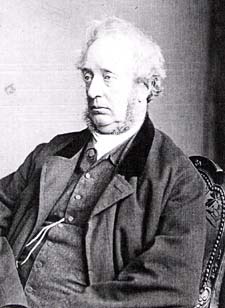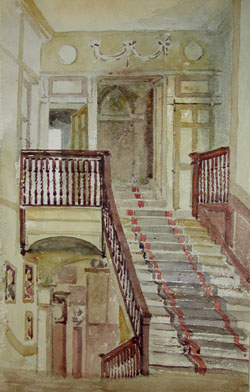Dr Hugh Welch Diamond
Physician, Photographer, Antiquarian and Collector
1803 - 1886

Hugh Welch Diamond was a 19th century polymath with wide interests. He came to live in Twickenham in 1858, where he opened a private asylum, principally for women, spending the remaining 28 years of his life here. He took a long lease of a property known as Twickenham House which occupied the land now covered by the properties of Heath Gardens on the south side of Heath Road. During his tenure the establishment was described as the Twickenham House Lunatic Asylum.
He was born on 23 October 1808 at Goudhurst in Kent (as stated in the 1861 Census), the eldest son of William Batchelor Diamond, a surgeon in the East India Company, probably of a Huguenot family who had settled in Kent early in the 17th century. Educated at Norwich Grammar School, from 1824 he studied medicine at the Royal College of Surgeons, moving to St Bartholomew's Hospital in 1828, and was then appointed house surgeon at the West Kent Infirmary in Maidstone.
Diamond married in 1831 and started private practice near Soho Square in London, remaining here until he was appointed superintendent of the women's department of the Surrey County Lunatic Asylum in 1848. He remained here for ten years.
Photography and Mental Health
In 1842 he became interested in mental health and spent time at Bethlem Hospital which had been built in 1815. He had also become interested in photography, taking his first picture three months after William Fox Talbot invented the negative-positive process in 1839. Thereafter he applied his skills to photographing mainly female patients at the asylum, so earning the description “the father of psychiatric photography”. It was his contention that this could aid diagnosis, treatment and act as a record of the cure of mental infirmity.
Thus it is both as a photographer and physician that he is remembered, although photography was much more than a vehicle for the study of mental health. He published widely on both subjects. He was a founder member of the Photographic Society of London, the Photographic Society Club and the Photographic Exchange Club.
Collector and Antiquary
In 1834 he was elected a Fellow of the London Society of Antiquaries. Much of his activity as a Fellow was concerned with the study of ceramics and the history of prints and engravings, of which he built up a substantial collection. In 1849 he presented to the Society a medieval brass, possibly of a Yeoman of the Crown, said to have been purchased some years before having been dredged from the bed of the River Thames.
He also used photography in the service of antiquarian investigation, leaving records of the cromlech at Plas Newydd, Anglesea, Melrose Abbey and Pipewell Gate, Winchelsea. He was active in the Society to the extent that he was elected honorary photographer in 1854.

Life at Twickenham
Diamond leased the property from Edward Saunders (1805-66), a brewer who owned the Britannia, a brewery and beer house nearby, behind the Red Lion Public House at the start of Colne Road.
Census Returns for 1861, 1871 and 1881 show that there were, in these years respectively, 8, 14 and 17 resident patients. They are only identified by their initials in the schedule. In 1871 there were two men, otherwise all the patients were women. They appear to have come mainly from the upper echelons of society, many described as “lady”, some as of “independent means”. Also noted was the daughter of a Field-Marshal, the daughter of a surgeon, a barrister and Fellow of a Cambridge college, the wife of a magistrate born in Madras and the wife of a journalist. Less obviously of gentle blood were the widow of a warehouseman, the wife of a grocer and the widow of a haberdasher.
Remarkably, in 1871 the establishment consisted of 30 people: family, staff, medical assistants and patients. All the patients were, apparently, accommodated in the house: there is no evidence of ancillary accommodation beyond the villa in the garden, reputed to have been occupied at one time by a “mad peer”. When the contents of the house were sold in 1887 there were 25 beds of one kind or another in 12 bedrooms, some of them double, some with straw palliasses, including two in the villa.
Dr Diamond appears to have married twice, first Jane Warwick on 14 June 1831 by whom he had 9 children. Secondly he married Teresa Butler (1826-c1878), sixteen years his junior. She claimed to have been born in Ireland in 1861, but Bristol in 1871. Their daughter, Teresa, apparently aged 23 in 1861and born in Bloomsbury was only 30 in 1871 and born in Chelsea. She looked after him when his second wife died.

Diamond Villa
While at Twickenham Dr Diamond hosted regular meetings with literary, antiquarian, photographic and artistic friends known as “Our Club”, for many years. These were held in a building in the garden later known as Diamond Villa. Numbered among these was George Wallis (1811-91), Keeper of Art Collections at the South Kensington (now Victoria and Albert) Museum from 1863 until his retirement in 1890. Wallis, today a somewhat forgotten figure was prominent during the second half of the century as a pioneer of Art Industry. His young daughter, Rosa came and painted both the villa and the main house inside and out following the death of Dr Diamond, probably as a tribute to his memory.
further reading
Oxford Dictionary of National Biography
Peter Melville Logan, Imitations of Insanity and Victorian Medical Aesthetics, Temple University
Notes & Queries, 1852 (photography)
Frank Sharman, George Wallis, a pioneer of art industry (online)



